This is a Chaika (ЧАЙКА) 3, a compact 35mm scale focus camera made between the years 1971 and 1973 in Minsk, Belarus during the reign of the Soviet Union by Вelаrusiаn Оpticаl and Mеchaniсаl Аssоciаtiоn or BeLOMO for short. As the name implies, the Chaika 3 was the third model in the Chaika series, all of which shot 18mm x 24mm half frame images on regular 35mm film. The Chaika 3 differed from the earlier models both by having an uncoupled selenium exposure meter and a detachable lens which could be installed onto an enlarger that appears may have never been made. Although no other lenses were made for this camera, the removability of the Industar-69 has made it a popular option to be adapted to digital mirrorless cameras today because of it’s unique character.
Film Type: Half-Frame 135 (35mm)
Lens: 28mm f/2.8 Industar-69 coated 4-elements in 3-groups
Lens Mount: M39 x 1, flange distance is 27.5mm so not LTM compatible
Focus: 0.8 meters to Infinity
Viewfinder: Scale Focus Galilean Finder with Projected Frame Lines
Shutter: Leaf Shutter
Speeds: 1/30 – 1/250 seconds
Exposure Meter: Uncoupled Selenium Cell w/ top plate exposure calculator
Battery: None
Flash Mount: Cold shoe and M and X Flash Sync
Other Features: None
Weight: 440 grams
Manual: https://mikeeckman.com/media/Chaika3Manual.pdf
How these ratings work |
The Chaika 3 is a compact and very nicely designed half frame camera that makes the most of it’s small size. With good ergonomics, a bright viewfinder, film advance lever, and an uncoupled selenium exposure meter and calculator, the Chaika gives you everything you need to make great images, without much bloat. These cameras are difficult to find in the US, but for overseas collectors, or that lucky buyer, are worth considering both for collectors and shooters alike. | ||||||
| Images | Handling | Features | Viewfinder | Feel & Beauty | History | Age | |
| 1 | 2 | 1 | 2 | 2 | 1 | 20% | |
| Bonus | none | ||||||
| Final Score | 10.8 | ||||||
History
For those new to collecting cameras, or even some who have been doing it a while, it is easy to associate all Soviet cameras with Russia. Certainly, a huge number of Soviet era cameras came out of Russian factories like KMZ, GOMZ, LOMO, and VOOMP and of course, most Soviet era cameras had Cyrillic or Russian language manuals and literature printed up as Russian was the national language of the Soviet Union.
To suggest all Soviet cameras are Russian however, fails to recognize cameras made in other Soviet era countries, such as Ukraine and Belarus. Ukraine had both the FED and Zavod Arsenal plants where millions of FED and Kiev rangefinders were made, along with other cameras such as the Salyut and Kiev 6×6 SLRs and the long lived FED 50 point and shoot camera.
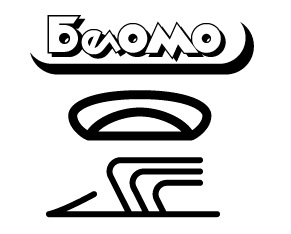 In Belarus, a large number of Zenit cameras and other photographic accessories were made in Vilejka, and cameras like the Chaika 3 reviewed in this article at the Belorussian Optical and Mechanical Association (BeLOMO for short) factory in Minsk, Belarus. BeLOMO was a combination of an earlier factory called Minsk Mechanical Factory (MMZ for short) and the previously mentioned Vilejka Zavod.
In Belarus, a large number of Zenit cameras and other photographic accessories were made in Vilejka, and cameras like the Chaika 3 reviewed in this article at the Belorussian Optical and Mechanical Association (BeLOMO for short) factory in Minsk, Belarus. BeLOMO was a combination of an earlier factory called Minsk Mechanical Factory (MMZ for short) and the previously mentioned Vilejka Zavod.
The MMZ factory first opened in May 1957, and was dedicated in honor of Soviet physicist Sergey Ivanovich Vavilov who pioneered work in physical optics and luminescence. Although the factory was not fully completed at it’s opening, MMZ debuted their first camera, a continuation of the early Smena 35mm camera, first produced by GOMZ in Leningrad, and some other lens grinding and polishing machines that would be used for future lens production.
Camera production continued while construction of the MMZ factory was ongoing. By 1960, when the factory was completed, nearly 300,000 Smena cameras had been produced along with several thousand copies of a simple medium format 6×6 camera called the Estafeta (Cyrllic: Эстафета), at least 300 lathes, and various other pieces of optical machinery.
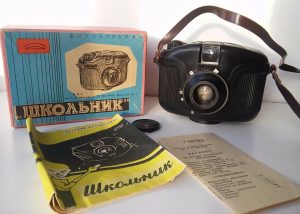
Two years later, MMZ would release it’s first two all new designs. The first was a simple injection molded plastic camera called the Vesna (Cyrillic: Весна) and another all plastic 120 roll film camera called the Shkolnik (Cyrillic: Школник). Both cameras were intended for a growing youth movement who were becoming increasingly interested in photography. Although not technically toy cameras, both the Vesna and Shkolnik were inexpensive, no frills cameras that could be afforded by anyone, even with a modest budget, introducing photography to a new generation of people.
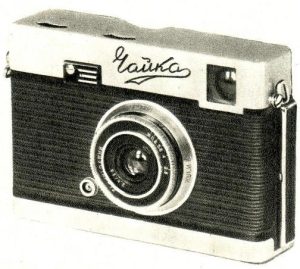
In 1965, a third all new camera called the Chaika (Cyrillic: Чайка) made it’s debut. Designed by V. I. Terechkov, the Chaika was a well made compact camera that shoots 18mm x 24mm “half frame” images on regular 35mm film. It had an attractive metal body, a bright Galilean optical viewfinder, behind the lens leaf shutter with speeds from 1/30 to 1/250, and came with a good Industar-69 28mm f/2.8 lens. Although simple, the Chaika was a bit more advanced than MMZ’s two other unique designs and the first MMZ camera to be exported to other countries.
The original Chaika was in production for only two years, of which 171,400 were made. In 1967, an updated model, simply called the Chaika-II was released which had some updated cosmetics with new body coverings that could be found in several shades of gray, dark red, green, and blue. The shutter release was redesigned and featured a socket for a shutter release cable, the folding rewind crank was turned into a large knob that was easier to grip, and perhaps the camera’s biggest change was that the Industar-69 was removable, with the intent to be used on a photographic enlarger, which may or may not have ever been built.
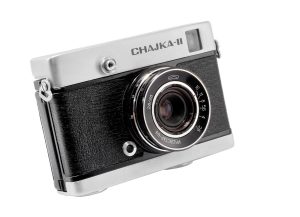
The Chaika-II was the most popular of all Chaika models, with 1,250,000 units produced from 1967 to 1972 and can be found with it’s logo in both Cyrillic and Roman characters. The Chaika-II was exported out of the Soviet Union, likely sold in various European countries and other emerging markets, but it is not clear if any ever made it to the United States.
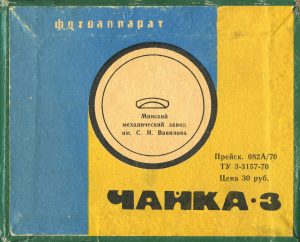
A third model called the Chaika 3 (notice the switch to the numeric ‘3’ as opposed to the Roman numeral as used with the previous model) made it’s debut in 1971 once again keeping the same basic shape and features of the Chaika-II, but this time featuring updated cosmetics with a bright line viewfinder and an uncoupled selenium exposure meter with exposure calculator on the top plate. Although the Chaika 3 uses the same removable Industar-69 lens and leaf shutter, the shutter loses the Bulb shutter speed, only offering instant speeds from 1/30 to 1/250. Early versions of the Chaika 3 had a film advance knob on the bottom plate like the previous models, but later models switched to a knob-like film advance lever.
The Chaika 3 was the first camera produced under the newly merged BeLOMO factory which consisted of both MMZ and Vilejka factories. Production of the Chaika 3 was about half that of the previous model, and it can only be found with Cyrillic letters on it, suggesting it was not available for export.
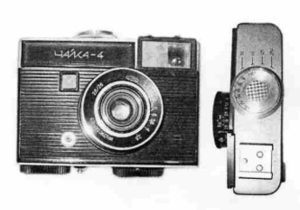
Around the same time the Chaika 3 was released, a fourth model, simply called the Chaika 4 was developed which featured the updated cosmetics and viewfinder of the Chaika 3, but without the meter. Strangely, the Chaika 4 never went into production, instead in 1972, a model called the Chaika 2M would be released with the same features, but different cosmetics. The Chaika 2M would be in production until 1974 at which time all Chaika models would be discontinued.
In the first decade and a half of BeLOMO’s existence, the factory was heavily influenced by both KMZ and GOMZ back in Russia. The relationships between Soviet optical factories is not always clear, but it appears as though MMZ was seen as a “sub-factory” of the two larger facilities in Krasnogorsk and Leningrad, allowed only to build some of the country’s cheapest cameras.
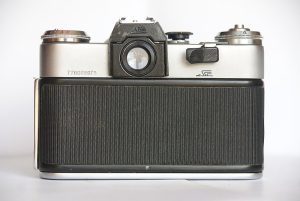
The early 1970s saw big changes for BeLOMO. First came the 1971 merger of MMZ and Vilejka, but in 1973, the start of production of Zenit-E SLRs, as dictated by KMZ. By this time, the Zenit-E was the Soviet Union’s best selling camera, and arguably, it’s most important. This was a camera that was exported all over the world. You could buy them under a huge number of name variants in Europe, China, Australia, and even the United States. Total production of all Zenit-Es would eventually exceed 12 million units, far exceeding what the KMZ factory was capable of, so to add extra capacity, BeLOMO was tasked with producing some versions of the camera. This came at the expense of BeLOMO’s other cameras, and models like the Chaika, Orion, and Vesna were dropped. Differentiating between KMZ and BeLOMO built Zenit-Es is pretty easy as the maker’s mark of either factory can be found on the camera. Eventually, new BeLOMO cameras like the Siluet, Elikon, and Agat 18 would be produced, but none with the complexity of a 35mm SLR.
Today, many different Soviet cameras are popular for collectors. Whether you are interested in the more advanced Kiev or Zorki rangefinders, medium format SLRs like the Kiev 80, or one of the other many different designs like the Voskhod, the selection is vast. I am not sure that simpler cameras like the Chaika series are exciting enough to warrant dedicated collectors, but I would suspect fans of half-frame 35mm and anyone interested in ex-iron curtain cameras, would find these interesting. One thing I’ve learned about the simpler Soviet cameras from this era, is that the lenses on them are surprisingly good, so models like the Chaika 3 are usually capable of excellent photographs, if you should find one in working order.
My Thoughts
I rarely seek out specific cameras to own, for the purposes of a review. A variety of the cameras reviewed on this site come to me via opportunistic impulse buys, loaners, or happy accidents. My wish list of cameras today is quite small, but for about a year, I had a passive interest in getting a Chaika 3. I really liked the look of the camera and knowing the reputation for Soviet triplets, I figured it would be a heck of a nice shooter.
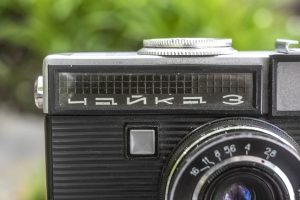
The problem I had with finding one is that few were exported to the US and of the Chaikas that made it here, most were the earlier models. Finding a nice Chaika 3 for a reasonable price without having to export it from a former Soviet country was a challenge. But as I covered in my GAS Attack! Buying Cameras on eBay article, the first two tips for buying cameras on eBay is Patience and Persistence. It took me well over a year of passive looking, but I finally found my camera, and it even came in the original box with some paperwork!
The Chaika 3 is a small camera, but it is not as light as it’s compact size would suggest. Weighing in at 440 grams, the camera is lighter than most full frame 35mm cameras, but is a bit heavier than an Olympus Pen or Fujica Half due to it’s mostly metal body. This is a camera that could easily fit into a small handbag or medium sized pocket, but it’s weight would definitely be noticed.
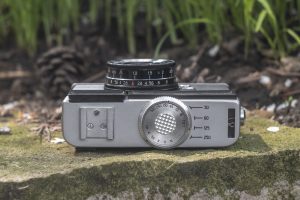
On the top plate are three things, the accessory shoe, and a large knob which functions both as the shutter speed selector and exposure calculator, and the match needle read out from the selenium exposure meter. For the first time user, the exposure calculator is a bit confusing, but is really simple to use. With the camera pointed at your subject, a small white needle in the read out will move to an unmarked position. The object is to move a metal arm with a circle on it to cover the needle. You do this by rotating the large shutter speed selector.
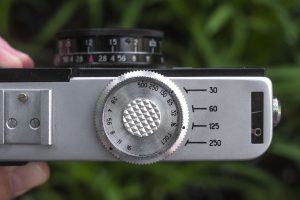
There are three parts to the shutter speed selector, the bottom piece which selects shutter speeds. As you turn this dial between the four speeds, you can feel noticeable changes between the speeds. I wouldn’t quite call them click stops, more like speed bumps that increase in resistance as you move the dial, then suddenly get easier when you reach the next speed. Then, there is the middle dial which actually controls the metal arm with the circle in the meter read out. Finally, an upper portion that spins a metal disc inside the middle dial.
It is this last disc that you must use to set the film speed loaded in the camera by aligning the speed with a black line on the top of the dial. Like most Soviet cameras from this era, the Chaika 3 only shows GOST (ГОСТ) film speeds, which are close to, but not the same as ASA. GOST to ASA conversion charts can be easily found online. The most common speeds are GOST 90 = ASA 100, GOST 180 = ASA 200, and GOST 350 = 400. Sadly, none of the indicated numbers on the camera correctly match up to any normal ASA speed, but with the known speeds, about halfway through 65 and 130 would be useful for ASA 100, halfway between 130 and 250 would be ASA 100, and halfway between 250 and 500 would be ASA 400.
After setting the film speed, aim the camera at your intended subject and rotate the entire dial between the four shutter speeds and see if you can get the metal arm with the circle to line up with the white needle. If you cannot, then you must separately rotate the middle dial while holding the bottom part of the dial still. This will continue to move the arm in the meter read out.
Once you have everything aligned, the shutter speed will already be set at one of the four positions, but you must make note of the aperture numbers opposite the GOST scale and see which of them most closely match a red dot on the outer dial. This likely sounds confusing, but in practice is not difficult. In the image to the LEFT, I have the film speed set halfway between GOST 65 and 130 which is ideal for Kodak Tmax 100, the shutter speed is set to 1/125, and although the meter needles are not lined up, assuming they were, the calculator is recommending f/11 for the given light. Since the exposure calculator is not in any way connected to the lens, the last step is that I must manually select f/11, or whatever the calculator recommended. While 99% of people today would likely just use a hand held meter, or some other exposure calculating device, you should remember that in 1971 when this camera came out, having a metered camera was a luxury that few could afford. The meter on the Chaika 3 would have been a big deal for the people who this camera was made for.
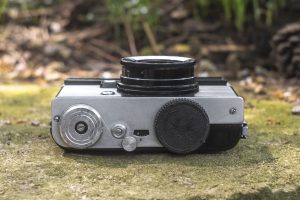
Flip the camera over, and on the bottom is the rewind knob, exposure counter, rewind release button, and depending on whether you have an older or newer Chaika 3, either a film advance knob or lever. This being a later model, it has the additional arm for the film advance lever. While I found the operation of the lever to be easy enough, I can’t say for certain whether it is a huge improvement over a knob. Being a half-frame camera, you only need to move the film a very small amount, so the amount you’d need to turn a knob compared to the lever is very small. The exposure counter is additive, showing how many exposures have been made and automatically resets when opening the film door.

The camera’s right side has a single wrist strap with a hidden surprise, which is typical of these smaller compact cameras as they’re much more convenient to use wrapped around your wrist than dangling from your neck. Hidden under the wrist strap however, is a 1/4″ tripod socket, which is a design feature that BeLOMO would later use on the Agat 18 and 18K half frame cameras. Simply unscrew the strap and place it somewhere so you don’t leave it, and if the need arises to mount the camera to a tripod you can. The lack of a Bulb mode, or anyway to shoot exposures longer than 1/30 or a self-timer makes this an unlikely thing for someone to do, however.
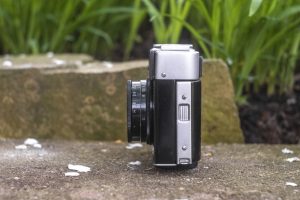
The camera’s left side is completely bare, other than the sliding latch for the film compartment. Simply pull down on the metal tab near the bottom of the latch and the right hinged film door swings open.
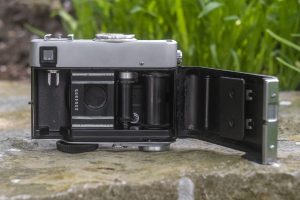
With the film compartment open, we see what you’d expect to see in a normal 35mm camera…just a lot smaller. Film transports from left to right onto a single slotted and fixed plastic take up spool. Simply thread the leader from a new roll of film into the rather large opening on the spool making sure one of the film perforations catches on a small tooth then give the spool a couple turns and close the door. The distance between the supply cassette and take up spool to the film gate is very small, which means you should very easily get a couple extra exposures on both the film leader and tail of a roll of film. Instead of getting 48 exposures on a 24-exposure roll, you should easily be able to get between 50-52 exposures, depending on how good you are at loading film.
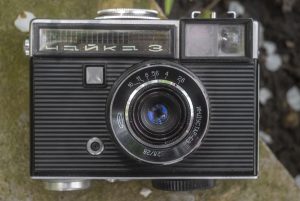
Up front, the Industar-69 lens has an aperture ring around the front lens element. Gripping this ring and turning it without smudging your finger on the glass lens takes some practice and usually requires you to lower the camera from your eye before changing, but otherwise, isn’t difficult to do. Changing focus is done by rotating the entire outer part of the lens. This is very convenient as the lens is very narrow, and had it required you to grip a separate ring, would be difficult to do. Focusing the lens from minimum to infinity requires about a 180 degree turn, which can be done in a single motion without having to reposition your hand. Marks exist on the focus scale for portrait, group, and landscape photos, but these are just suggestions based on what the depth of field would be at those distances.
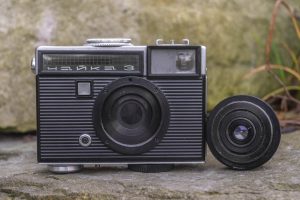
Removing the lens is easy to do as the mount is a simple screw mount. Grip the lens by it’s base, closest to the body and rotate counterclockwise to remove and clockwise to mount. Since there was never any other lenses made for the Chaika 3, this isn’t something you’re likely to do often unless you plan on adapting the lens to another camera.
The front plate is nicely styled with a black piece of plastic with a horizontal ribbed pattern. The shutter release is a square gray button above and to the left of the lens and is in a very comfortable position for your right index finger. This being a small camera, those with large hands might have to bend their index finger at a strange angle to hit it, but for me, pressing the button felt natural, and without effort. The shutter release is not threaded for a shutter release cable, which is a strange omission from earlier Chaikas who had such a button and a Bulb mode for the shutter. Perhaps the inclusion of the light meter required it’s removal? Below the shutter release is a flash sync port.
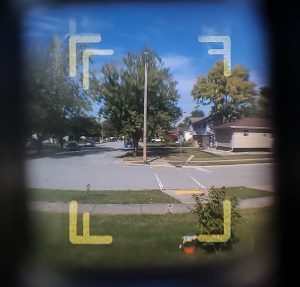
The viewfinder is small and simple, with nothing to see other than projected frame lines with manual parallax correction marks. The frame lines have a gold color and have good contrast compared to the main image. This being a scale focus camera, there is no rangefinder patch, nor is there any information about exposure. Although small, I had no problem seeing all four sides of the frame lines while wearing prescription glasses.
The Chaika 3 is a good looking and interesting camera as it is both larger and heavier than many Japanese half frame cameras, but in it’s heft gives some reassurance that the camera can take a few bumps and bruises. It’s size and front location of the shutter release give it good ergonomics that is comfortable to hold. Having only four shutter speeds to choose from will limit you from shooting in extremely bright or low light situations, but should be good enough for most average light photography. The coupled meter and exposure calculator is crude by today’s standards, but works surprisingly well, and finally, with features such as a film advance lever, projected frame lines, an automatic resetting exposure counter, and flash synchronization makes the camera feel more like a real camera, than a toy.
Of course, a camera needs to make photos, so how well does it do at that?
Repairs
I did not have any problems with the Chaika 3 that I used in this review, but in my research for this article, I came across several mentions of people where their shutter gets jammed due to a fault in the shutter release. The fix is detailed in a blog post by Rachael Levasseur from September 2009 that I have copy and pasted below in case it ever disappears. Thanks Rachael!
- Turn on a really bright light and grab a magnifying glass or loupe; you may need it.
- Unscrew and remove the lens.
- Look at the very top into the body just below where the lens screws in. You’ll see a peg and a little triangular tab. If you don’t, use your magnifying tool.
- Use an unfolded paper clip to move the peg, you should see the shutter release. The tab is supposed to move the peg when you release the shutter. The tab is jammed. Simply move it toward the peg, it should push the peg, release the shutter, and un-jam.
- Put the lens back on, and make sure that when you advance the film, you pull the lever as far back as it will go, so that it doesn’t jam again.
My Results
My first roll of film through the Chaika was completely spontaneous and without much thought. I was planning a trip for Mother’s Day in 2022 up to northern Michigan where my family had rented a cabin. I had a small bag packed with cameras to bring, and after filling it up, I saw there was enough room for one additional camera, so having recently acquired the Chaika, I threw it in the bag with a half finished roll of Fuji 200.
There’s always been something about images shot from a half frame camera that make them instantly recognizable. While you’d expect there to be a difference when halving the surface area of your exposure from a 24mm x 36mm full frame image, half frame images have a certain “glow” that I can’t describe. Maybe it’s the easier to see grain or in how the wider focal length of half frame camera lenses affect the smaller negative. Whatever the case, the images from the Chaika 3 all have that look.
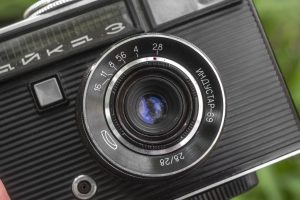
If you’re a pixel peeper, you’ll likely be disappointed in the quality of the images, but for the purposes half frame 35mm cameras were created, which is to create snapshot quality images at a more affordable price, the Chaika 3 does as good of a job as any camera, Soviet, Japanese, or German, that I’ve seen.
I’ve said it a bunch of times on this site, but Soviet triplets never cease to amaze me and the 3-element Industar-69 is no exception. Sharpness is excellent in the center with minimal fall off near the corners. No vignetting is visible in images where the sky is present, although some out of focus details are a bit mushy.
Unfortunately, the color quality of the half finished roll of Fuji 200 that I shot seems to have aged poorly with a prominent cyan hue across all images. This is a film stock that definitely shows it’s age. Fresh Fuji 200 can look great, but as soon as it reaches it’s expiration date, all bets are off. I was a little disappointed in the muted colors in a few of these images which I feel fresh film wouldn’t have had, but there’s still enough here to see that the camera did a wonderful job.
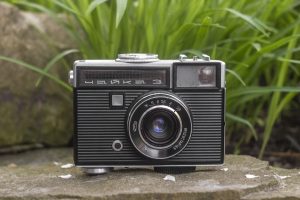
The Chaika 3 is very enjoyable to use. The camera is compact and very portable. It’s not quite as small as an Olympus Pen, and the 90 degree angled corners prevent it from seamlessly slipping in an out of a pocket. This example was missing the wrist strap which I would have liked to have as the camera is light enough to dangle from your wrist in an all day adventure at a park or the zoo.
The viewfinder is just the right size so as not to be too small, but big enough to where I could see the entire image, even while wearing prescription glasses. The camera’s controls are easy to reach, with the square shutter release button in a very convenient location up front. In fact, I would say that with larger hands, the location of the button on the front is much easier to reach than had it been located on the top plate. The film advance lever on the bottom of the camera has a short throw and is easy to use. Lastly, changing shutter speeds and f/stops is pretty straightforward, although I would have preferred if both were located in the same area, rather than f/stops on the lens, and shutter speeds on the top plate.
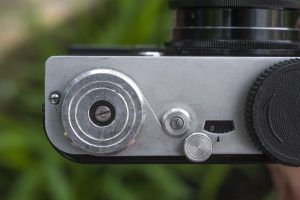
The only parts of the camera that aren’t very intuitive to use are the exposure meter and calculator on the top plate. Since I don’t read Russian, I was unable to refer back to a user manual, but having shot other cameras with similar exposure calculators, I was able to figure it out pretty quickly. While the metering system was likely a big selling point when the camera was new, I don’t think it’s all that necessary. Shooting the camera with a handheld meter or using Sunny 16 is definitely my preferred method, and one that I employed during the test roll.
Overall, the Chaika 3 is an excellent camera. It is compact and portable, well built, has a good lens, and it’s ergonomics never get in the way of it’s use. Sure, it’s not as sleek as many Japanese half frame cameras, and it is limited to only 4 shutter speeds, but when used to it’s strengths, it is a very capable camera, and one I’d have no problem recommending to users and collectors alike!
Related Posts You Might Enjoy
External Links
http://www.sovietcams.com/index2ff1.html
https://all-my-cameras.com/2012/09/21/chaika-3-чайка_en/
https://vintagecameraquest.wordpress.com/2017/06/05/chaika-3/
https://liveviewer.ru/en/2021/08/chajka-3-na-vsyakij-sluchaj/
http://photohistory.ru/index.php?pid=1207248177574586
https://www.lomography.com/magazine/31176-chaika-3-half-frame-for-the-space-age

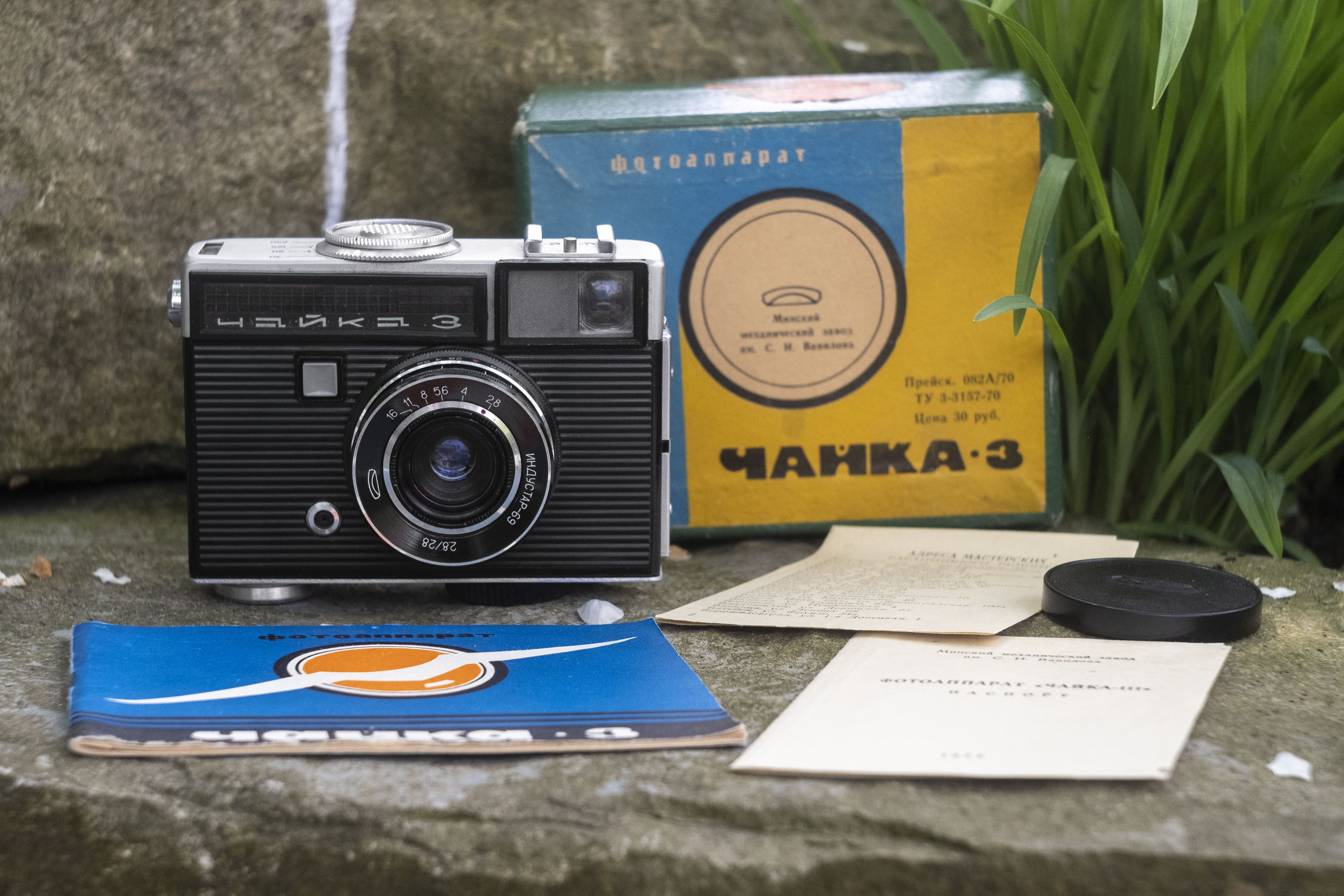
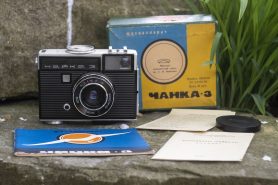
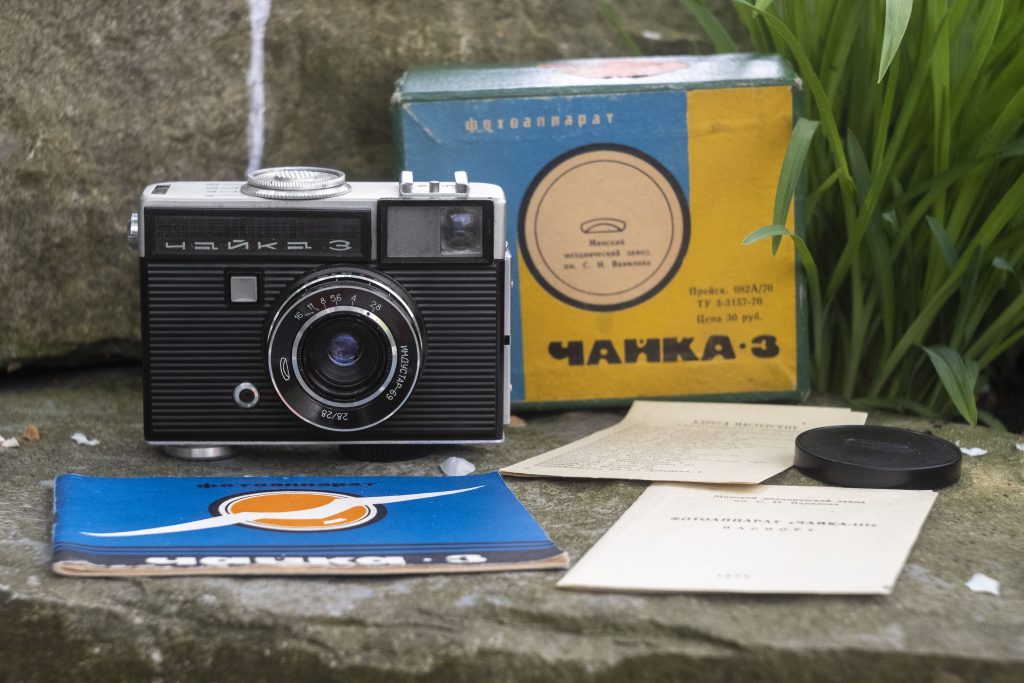



















Industar- 4 elements in 3 group, tessar lens.